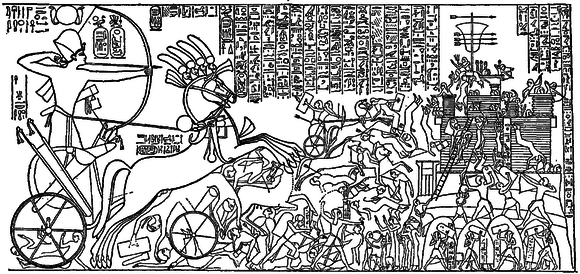I have recently finished the manuscript of a book tentatively entitled Fighting for God and King: A Topical Survey of Warfare in the Ancient Near East, which will be published by SBL Press at some point in the future. The book is designed to be a sourcebook on all topics related to warfare in the ancient Near East to enable those studying Scripture to know more of the cultural background of the Old Testament. Over the next few months as the book goes through copy editing and page proofs, I am planning on highlighting a few texts and pictures from the book to illustrate some aspects of Old Testament texts (this post will have one text and one picture along with an overview of the book). I hope you enjoy the journey!
I’ll provide you today with two items to illustrate an empire’s approach to warfare. First, Sargon II described a battle against the Babylonian king Marduk-apla-iddinna (called Merodach-baladan in the Old Testament) in epic terms, emphasizing the defensive measure taken by the Babylonian, the humiliation of the enemy, and the power of the Assyrian army. The message was clear: it was futile to resist Assyrian power.
Before me, Marduk-apla-iddinna gathered together his inhabited towns and the gods dwelling in them and brought them in to the city of Dûr-Iakin and strengthened its defence. He set off ten ‘poles’ (distance) in front of its main wall and made two hundred cubits the width of the moat went down one-and-a-half ‘poles’ (until) he reached water-level. He cut a breach from the Euphrates and let it flood its (the city's) cultivation; its meadow lands, the place of battle, he soddened with water, and made difficult the crossing. He himself together with his accomplices his men of battle, between the streams, like a duck, he pitched his royal tent and drew together his encampment. At the command of the gods Aššur, Nabu, and Marduk across his streams I made (my soldiers) lay down a bank (of earth). He himself, together with his warriors, like a flying eagle I caught him in a net, the corpses of his nuballi and of the Aḫlamu, desert-folk who went at his side, (with these) like very ‘rats’ I filled the precincts of his city.[1]
Second, a line drawing of a relief from Ramses II that shows his siege of an enemy city illustrates many of the themes of warfare in the ancient Near East: the gigantic size of the warrior king in his chariot to the left, the dominance of the bow and the chariot, the chaos of siege warfare to the right, and the almost ritual smiting of an enemy in the bottom middle of the scene (the warrior who holds an enemy by the hair with his left hand and preparing to smite him with his outstretched right hand). Like the text above, such pictures sought to demonstrate the utter futility of resisting the empire.

Line drawing of relief from temple at Thebes; Photo courtesy of T. K. Cheyne and J. S. Black, eds., Encyclopaedia Biblica, 1903 (2:1223-24)/Wikimedia Commons
The book will include such topics as casus belli (why nations went to war), preparations for war (marching to war, providing food and water, preparing defenses), the battles themselves (such as open field battles, sieges, and ambushes), results of war (prisoners, genocide, victory rituals, laments), officers and soldiers (command structure of armies, size of armies, lives of the common soldiers), weapons and armor, and divine warriors. The book not only has quotations of texts, but also 150 pictures to illustrate warfare. Each topic is broken up into smaller cultural sections (Egyptians, Hittites, Early Mesopotamia, Assyria, Later Empires, and West Semitic) to show differences between various times and regions.
[1] C. J. Gadd, “Inscribed Prisms of Sargon II from Nimrud,” Iraq 16 (1954): 186–87.
 Biola University
Biola University
.jpg)
.jpg)

